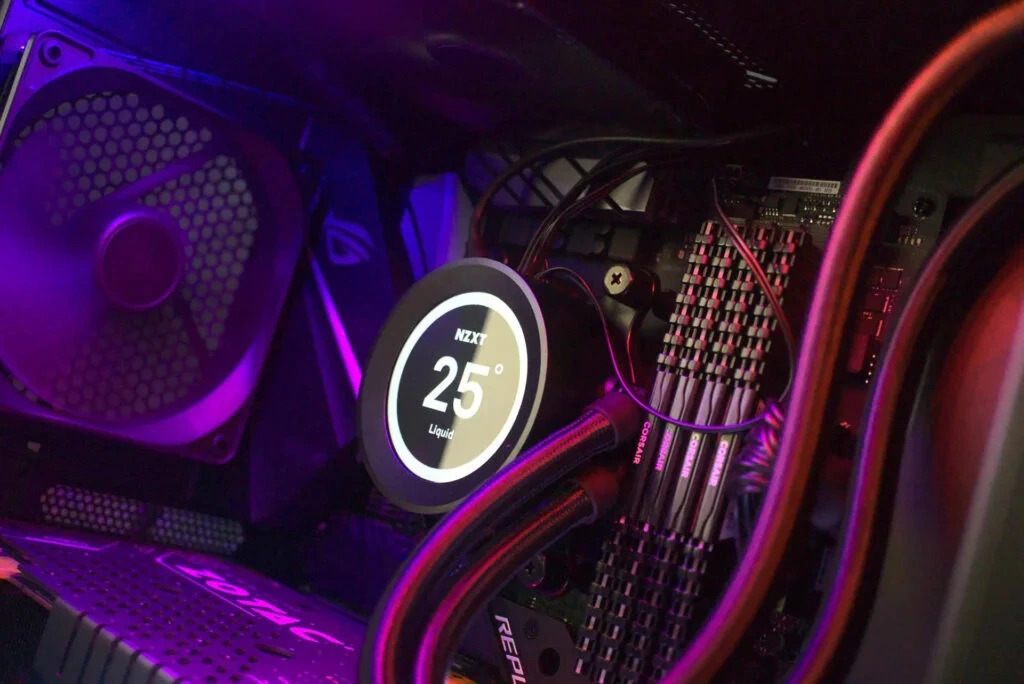The ideal CPU temperature is 30°C-50°C (86°F-122°F) when idle and 60°C-80°C (140°F-176°F) under load. Monitoring these helps ensure performance and longevity.
Your computer’s processor, or CPU, is essential for handling tasks and ensuring smooth operation. It’s crucial to know the ideal temperature for your CPU to avoid overheating and maintain performance. Typically, modern CPUs should run at temperatures between 30°C to 50°C (86°F to 122°F) when idle, meaning when your computer is not performing demanding tasks.
Your processor’s temperature should ideally range between 30°C to 40°C (86°F to 104°F) when idle and 60°C to 80°C (140°F to 176°F) under load. Higher temperatures may indicate cooling issues. For gaming or heavy tasks, ensure your CPU stays below 85°C to avoid thermal throttling or potential damage.
When your CPU is under heavy load, such as during gaming or video editing, temperatures may rise to between 60°C to 80°C (140°F to 176°F). Always check your CPU’s specific temperature guidelines from the manufacturer to ensure it stays within a safe range.
How to Check Your Computer’s CPU Temperature:
Monitoring your CPU temperature can help you prevent overheating and ensure your computer runs efficiently. You can check your CPU temperature using various methods. One way is through the BIOS or UEFI settings. Restart your computer and enter BIOS/UEFI by pressing a key like DEL or F2 during startup.
Look for the hardware monitor section to view temperature readings. Alternatively, you can use third-party software like HWMonitor, Core Temp, or Speccy, which offer real-time temperature data and other system statistics. Manufacturer-specific tools like Intel Extreme Tuning Utility or AMD Ryzen Master also provide temperature monitoring.
Why Monitor CPU Temperature:

Keeping an eye on your CPU temperature is essential for several reasons. Overheating can cause your CPU to throttle its performance, leading to reduced speed and efficiency. In severe cases, it may even cause permanent damage. Regular monitoring helps prevent these issues by ensuring your CPU remains within safe operating temperatures.
Additionally, managing CPU temperature can improve performance by avoiding thermal throttling, where the CPU slows down to cool off. Monitoring also helps extend the lifespan of your CPU by preventing the wear and tear caused by excessive heat.
How to Check CPU Temperature in Windows 10 & 11:
To check your CPU temperature in Windows 10 and 11, you’ll need to use third-party software, as the operating system doesn’t have built-in temperature monitoring. Download and install programs such as HWMonitor, Core Temp, or Speccy. These tools provide real-time data on your CPU temperature and other important system metrics.
Open the software to view current temperature readings. Additionally, CPU manufacturers often offer their own tools, like Intel Extreme Tuning Utility or AMD Ryzen Master, which can be downloaded from their respective websites for more detailed monitoring.
Understanding Safe CPU Temperatures:
Understanding what constitutes a safe CPU temperature is key to maintaining optimal performance. Generally, CPUs should be within the following temperature ranges: 30°C to 50°C (86°F to 122°F) when idle, and 60°C to 80°C (140°F to 176°F) under load. These ranges can vary depending on your CPU model and manufacturer’s specifications.
Always refer to the guidelines provided by your CPU manufacturer for the most accurate information. Staying within these temperature ranges helps ensure that your CPU performs efficiently and avoids overheating issues that could affect your computer’s performance.
Also read: Socket 1150 Processors List – Features and Recommendations!
Troubleshooting High CPU Temperatures:
If your CPU temperature is higher than normal, several troubleshooting steps can help address the issue. First, check the cooling system to ensure that the CPU cooler is properly installed and functioning. Clean any dust from fans and heatsinks, as dust buildup can impede cooling.
Reapplying thermal paste between the CPU and cooler may also help, as old or degraded paste can reduce cooling efficiency. Improve your computer’s airflow by adjusting or adding case fans if needed. Finally, consider updating your BIOS/UEFI, as some updates can enhance thermal management and improve cooling performance.
What is a Good and Normal CPU Temp:
A good and normal CPU temperature depends on the processor’s activity level and workload. Typically, during normal usage, such as browsing the web or working on documents, a CPU temperature between 30°C to 50°C (86°F to 122°F) is considered normal. Under more demanding tasks like gaming or running intensive applications, temperatures between 60°C to 80°C (140°F to 176°F) are expected.
These ranges ensure that the CPU operates efficiently without overheating. Always refer to your CPU’s specific guidelines for the most accurate temperature ranges based on your hardware and usage patterns.
Average CPU Temp:
The average CPU temperature can vary based on factors like usage, environment, and cooling efficiency. Generally, during regular activities such as web browsing or light multitasking, you can expect temperatures around 40°C to 60°C (104°F to 140°F).
When the CPU is under more intensive workloads, like gaming or video editing, temperatures may rise to between 60°C to 80°C (140°F to 176°F). These temperature ranges are considered normal and indicate that your CPU is functioning within safe limits. Regular monitoring can help ensure that temperatures remain within these average ranges for optimal performance.
Safe CPU Temp:
Maintaining a safe CPU temperature is crucial to prevent overheating and ensure the longevity of your processor. Most CPUs should ideally operate at temperatures between 30°C to 50°C (86°F to 122°F) when idle. During high-demand tasks, temperatures between 60°C to 80°C (140°F to 176°F) are generally safe.
Going beyond these ranges can lead to performance issues, thermal throttling, or even hardware damage. Always check the manufacturer’s guidelines for your specific CPU model to determine the safe operating temperature range. Proper cooling and regular monitoring can help keep your CPU within these safe temperature limits.
How Hot is Too Hot for a CPU:

Knowing how hot is too hot for a CPU can help you avoid performance issues and potential damage. Most CPUs are designed to handle temperatures up to around 90°C to 100°C (194°F to 212°F) before starting to throttle performance to prevent overheating.
However, consistently running at these high temperatures can lead to thermal throttling and reduce the lifespan of your CPU. It’s best to keep your CPU temperatures well below these limits for optimal performance and longevity. Regular monitoring and maintaining proper cooling can help ensure your CPU stays within safe temperature ranges.
Good CPU Temp While Gaming/Streaming:
When engaging in resource-intensive activities like gaming or streaming, it’s normal for your CPU temperature to rise. Ideally, during such high-demand tasks, you should aim for temperatures between 60°C to 80°C (140°F to 176°F). These temperatures are considered normal and safe for most CPUs while under load.
To ensure that your CPU remains within these temperature ranges, make sure your cooling system is effective and your computer has good airflow. If temperatures exceed these levels, you may need to improve your cooling solution or optimize your system settings to prevent overheating and maintain performance.
Your processor’s ideal temperature depends on its make and model, but generally, idle temperatures should range between 30-50°C, while under load, 60-85°C is acceptable. Modern CPUs have built-in thermal limits, typically around 100°C, to prevent damage. Consistently high temperatures may indicate cooling issues or poor airflow. Regular maintenance and quality thermal paste can help ensure optimal performance and longevity.
FAQ’s:
1. What is a normal CPU temperature when idle?
A normal CPU temperature when idle is between 30°C to 50°C (86°F to 122°F).
2. How can I check my CPU temperature?
You can check your CPU temperature using BIOS/UEFI settings, third-party software like HWMonitor, or manufacturer-specific tools like Intel Extreme Tuning Utility.
3. What should I do if my CPU temperature is too high?
If your CPU temperature is too high, ensure proper cooling, clean dust from fans, reapply thermal paste, and improve airflow in your computer case.
4. What is considered a high CPU temperature?
A CPU temperature consistently above 80°C (176°F) is considered high and could indicate overheating issues.
5. What is a safe CPU temperature range while gaming?
A safe CPU temperature range while gaming is between 60°C to 80°C (140°F to 176°F).
Conclusion:
In conclusion, maintaining the right CPU temperature is crucial for ensuring optimal performance and extending the lifespan of your computer. By keeping your CPU within the ideal temperature range—30°C to 50°C when idle and 60°C to 80°C under load—you can prevent overheating and performance issues.




